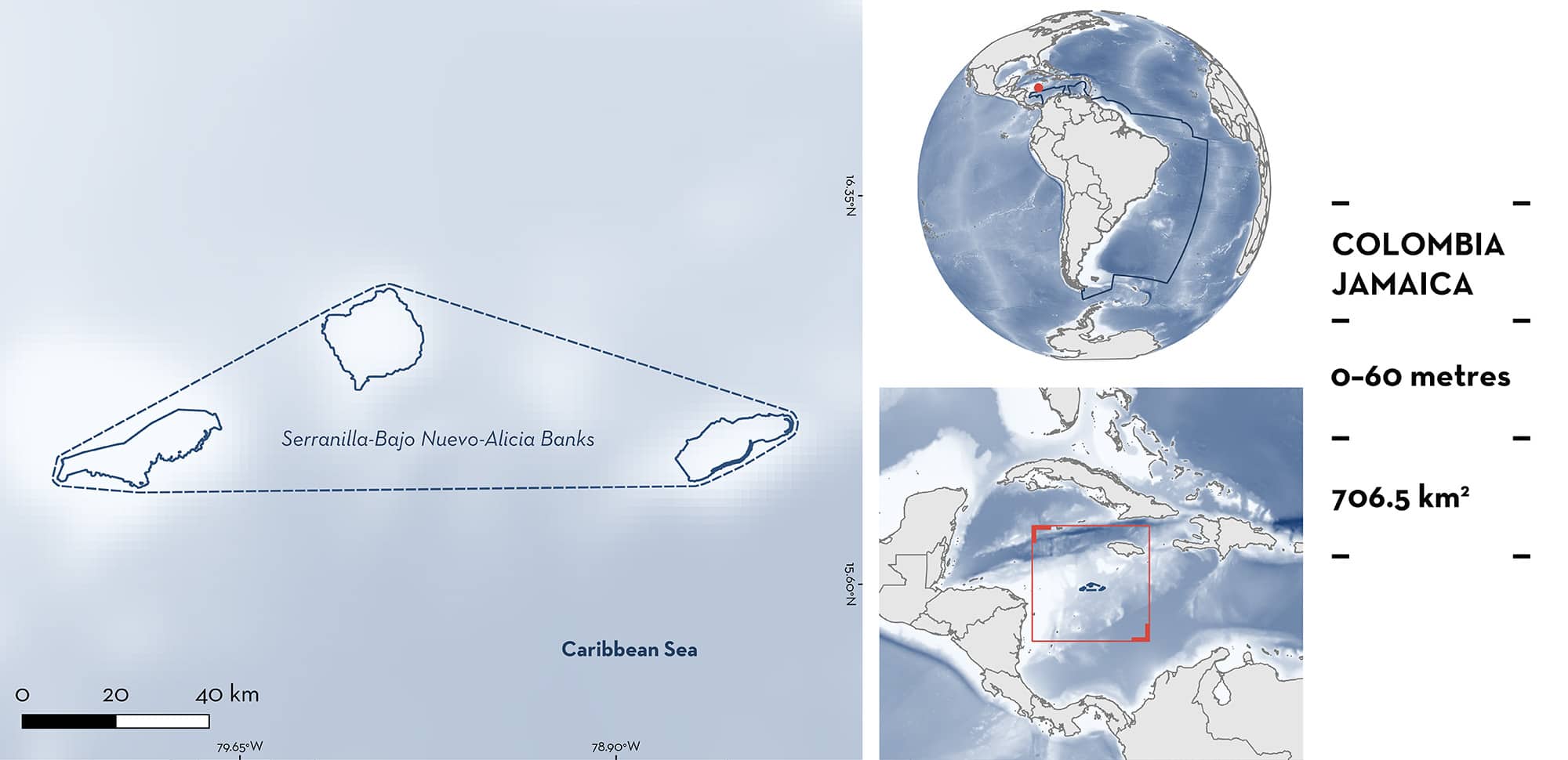ISRA FACTSHEETS
ISRA FACTSHEETS
SOUTH AMERICAN ATLANTIC REGION
Serranilla-Bajo Nuevo-Alicia Bank
Summary
Serranilla-Bajo Nuevo-Alicia Bank is located in Colombian and Jamaican waters. The area is situated in the western Caribbean Sea and comprises three small atolls with barrier reefs, cays, and shoals. It overlaps with the Seaflower Biosphere Reserve marine protected area. Within this area there are: threatened species (e.g., Caribbean Reef Shark Carcharhinus perezi) and undefined aggregations (e.g., Atlantic Nurse Shark Ginglymostoma cirratum).
Download factsheet
Serranilla-Bajo Nuevo-Alicia Bank
DESCRIPTION OF HABITAT
Serranilla-Bajo Nuevo-Alicia Bank is located in Colombian and Jamaican waters. The area is situated in the western Caribbean Sea. It is found ~220 km southwest of Jamaica and ~800 km from the Colombian mainland. It comprises three banks: Serranilla, Bajo Nuevo, and Alicia Bank Serranilla is a round semi atoll with a discontinuous barrier reef in the southeast. It has multiple cays and emerging rocks. Bajo Nuevo is a small atoll with a barrier reef divided by a deep channel (~60 m). Alicia Bank is a submerged atoll with a small barrier reef in the east side (Abril-Howard et al. 2012; Vega-Sequeda et al. 2016). Two main seasons dominate the area: a dry season from February to April and a rainy season from June to December (Ballesteros-Galvis 2007). Sea surface temperatures range between 26–30 °C (Monroy-Silvera & Zambrano 2017).
The area overlaps with the Seaflower Biosphere Reserve marine protected area (UNEP-WCMC & IUCN 2025).
This Important Shark and Ray Area is benthic and pelagic and is delineated from inshore and surface waters (0 m) to 60 m based on the bathymetry of the area.
CRITERION A
VULNERABILITY
Two Qualifying Species considered threatened with extinction according to the IUCN Red List of Threatened Species regularly occur in the area. These are the Endangered Caribbean Reef Shark (Carlson et al. 2021b) and the Vulnerable Atlantic Nurse Shark (Carlson et al. 2021a).
CRITERION C
SUB-CRITERION C5 – UNDEFINED AGGREGATIONS
Serranilla-Bajo Nuevo-Alicia Bank is an important area for undefined aggregations of two shark species.
Aggregations of Caribbean Reef Sharks have been regularly observed in Baited Remote Underwater Video Station (BRUVS) surveys and in fisheries operating in the area (MacNeil et al. 2020; D Cardeñosa unpubl. data 2024). In 2017, 41 BRUVS were deployed in the area. Caribbean Reef Sharks were observed in 16 deployments, and aggregations of 3–5 individuals (MaxN [maximum number of individuals of a species observed in a single frame]) were recorded in four deployments at 8–16 m depth. This area had the highest MaxN recorded across all the islands, keys, and banks in the Colombian Caribbean, including islands found ~400 km south (MacNeil et al. 2020; D Cardeñosa unpubl. data 2024). In 2022, 30 BRUVS were deployed in the area and aggregations of 3–5 individuals were also recorded (D Cardeñosa unpubl. data 2024). Historically, this area has sustained a large abundance of the species. Between January and December 2005, five fishing trips using longlines (500–1,000 hooks) were conducted across the islands of the Colombian Caribbean (Ballesteros-Galvis 2007). In 92 days of fishing across the whole region, Caribbean Reef Shark was the species with the highest number of individuals caught (n = 1,358). Of these individuals, 689 (50.7%) were caught in the area during 16 days of fishing and represented the largest relative abundance for the species recorded across the islands of the Colombian Caribbean (Ballesteros-Galvis 2007). Additional information is needed to confirm the nature and function of these aggregations.
Aggregations of Atlantic Nurse Sharks have been regularly observed in BRUVS and in fisheries operating in the area (MacNeil et al. 2020; D Cardeñosa unpubl. data 2024). During 2017 and 2022, 71 BRUVS were deployed in the area. Atlantic Nurse Sharks were observed in 33 deployments and aggregations (MaxN = 3–5) were recorded in seven deployments at 9–16 m depth. During underwater visual surveys conducted in 2011 (n = 53), Atlantic Nurse Sharks were regularly recorded in the area (Vega-Sequeda et al. 2016). Historically, this area has sustained a large abundance of the species. Between January and December 2005, five fishing trips using longlines (500–1,000 hooks) were conducted across the islands of the Colombian Caribbean (Ballesteros-Galvis 2007). In 92 days of fishing across the whole region, 143 Atlantic Nurse Sharks were caught. Of these individuals, 66 (46.1%) were caught in the area during 16 days of fishing and represented the largest relative abundance for the species recorded across the islands of the Colombian Caribbean (Ballesteros-Galvis 2007). Additional information is needed to confirm the nature and function of these aggregations.
Download factsheet
SUBMIT A REQUEST
ISRA SPATIAL LAYER REQUEST
To make a request to download the ISRA Layer in either a GIS compatible Shapefile (.shp) or Google Earth compatible Keyhole Markup Language Zipped file (.kmz) please complete the following form. We will review your request and send the download details to you. We will endeavor to send you the requested files as soon as we can. However, please note that this is not an automated process, and before requests are responded to, they undergo internal review and authorization. As such, requests normally take 5–10 working days to process.
Should you have questions about the data or process, please do not hesitate to contact us.


